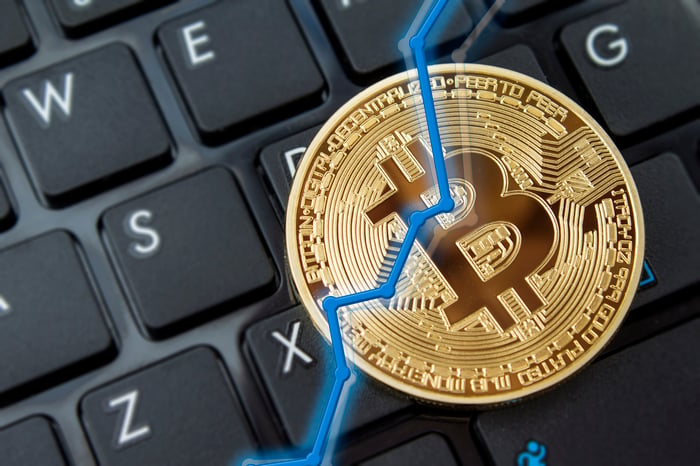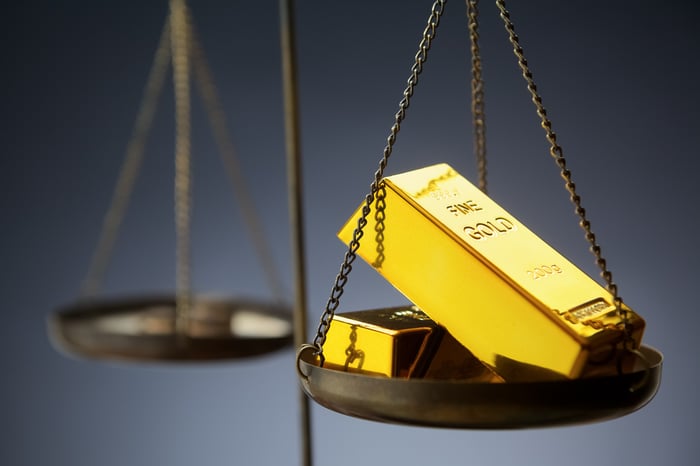Despite the broad-based S&P 500 having nearly quadrupled since hitting its trough in March 2009, this year belongs to cryptocurrencies. Since beginning the year with an aggregate market cap of $17.7 billion, the value of more than 1,300 virtual currencies combined tipped the scales at $335 billion on Dec. 3, working out to a year-to-date return of a cool 1,792%! By comparison, it's taken the stock market decades to deliver similar returns.
All hail the almighty bitcoin!
Though it may not be the top performer on a percentage basis, given that it's only up a bit over 1,000% for the year (terrible, right?), bitcoin is leading the crypto-revolution. As of Dec. 3, bitcoin was valued at $11,100 per coin, giving it a market cap of $185 billion. That's larger than Dow Jones Industrial Average stalwarts like Walt Disney, General Electric, and Boeing.

Image source: Getty Images.
The catalysts behind the rally in bitcoin are almost too many to count, but they essentially trace back to a few core positives. One is the clear intrigue surrounding blockchain technology, which records all transactions in a secure and efficient manner without the need for a financial intermediary like a bank. Having these open-source networks underlying virtual currencies opens news doors with regard to security (i.e., altering logged data becomes very difficult), and with regard to hastening peer-to-peer and business-to-business transactions.
A weaker dollar has also played a key role in pushing bitcoin higher. When the dollar falls, investors holding cash usually seek a better store of value. Typically, gold is the go-to investment given its scarcity. In other words, the gold we have on this planet now is all there will ever be. However, bitcoin has protocols limiting the number of mined coins to 21 million, giving it a degree of scarcity, too, and allowing some crypto-investors to choose bitcoin over gold.
When it comes to bitcoin, there's also a lot of excitement surrounding its potential as a payment facilitator. There isn't a virtual currency that has more merchants under its belt than bitcoin. Though Overstock.com has welcomed a half-dozen cryptocurrencies tokens with open arms, bitcoin managed to snag other big players, including Microsoft, PayPal Holdings, Intuit, and DISH Network. Presumably, the higher bitcoin heads, the more consumer interest there will be, thus giving merchants incentive to consider adding it as a payment option.
Move over, bitcoin: This ancient currency is going digital
But bitcoin isn't the only pony in town by a long shot, even if it does make up more than half of the aggregate cryptocurrency market cap. As noted, there are more than 1,300 other virtual currencies, many of which have underlying blockchain technology that businesses can test. The barrier to entry in developing blockchain is pretty low, meaning bitcoin's perch is under constant threat from burgeoning virtual currencies.

Image source: Getty Images.
It's not even safe from competition from physical currencies. Gold, which has been used as a currency for a little over 2,700 years, is about to go digital and challenge the very core of bitcoin's merchant and peer-to-peer network.
As CNBC reported in November, financial technology firm Glint is launching an electronic payment app that'll allow people to buy goods and services using gold. The app will link a Mastercard (MA -0.14%) debit card to their phone, allowing them to buy physical gold bullion that's stored in a Swiss vault. Users can then choose to pay for goods and services using their gold bullion, or could even complete peer-to-peer money transfers in bullion as opposed to traditional currencies. Glint is planning to add traditional currencies aside from gold as well. Considering gold is about an $8 trillion market (if not more, depending on your source for resource estimates), there are probably plenty of investors and consumers who'll be interested in the digitization of this lustrous yellow metal.
It's also worth pointing out that this isn't Mastercard's first swipe at bitcoin, either. In October, the global payment facilitator announced that it would begin allowing certain banks and merchants to facilitate payments over its own version of blockchain.
As hard as it tries, bitcoin can never become the new gold
Though it's been suggested that bitcoin could become the new gold, this writer, who is a believer in the long-term appreciation of gold and a cryptocurrency skeptic, believes bitcoin has virtually no chance to replace the lustrous yellow metal.

Image source: Getty Images.
The first thing investors have to consider is that when it comes to scarcity, gold holds the clear advantage. As noted, the gold that's in the ground now, and what we've mined, is all we're ever going to have. Comparatively, bitcoin's protocols limit the number of coins that can be mined to 21 million, giving it a degree of scarcity. But unlike gold, which is a physical finite resource, bitcoin's protocols could always be rewritten to allow for more mining. Additionally, currency forks, such as when bitcoin split into two virtual currencies (bitcoin and bitcoin cash) over the summer, place an asterisk next to the finiteness and true scarcity of bitcoin.
Gold also has history on its side. It's been used as a currency for more than 2,700 years, can be somewhat easily converted into other currencies, and has the full support of global governments. Bitcoin, on the other hand, is banned in at least a half-dozen countries, and often raises the eyebrows of government officials.
Bitcoin also has a very long way to go before it has any chance of rivaling gold's market cap. At the moment, bitcoin is only worth about 2% of gold's presumed value.
If given the choice, this investor would choose gold over bitcoin any day of the week.





